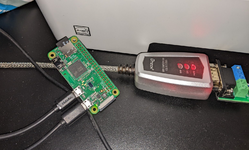This has made the rounds on youtube and on Twitter, so here goes an attempt to make a comprehensive thread about it.
A Canadian computer called the NABU, which didn't have disk drive storage, tape cassette or anything (just a keyboard, joystick port and expansion ports for printer, disk drive etc), it took its software from a cable subscription channel, held on from 1983 to 1986 and didn't make it outside of the Ottawa region.
PellMill LLC is selling 2000+ NOS units that were bought in 1989 and held onto during all that time. When the NABU computer was featured in an Adrian's Digital Basement video, the floodgates opened while everyone scrambled to get one, even if most had never heard of it. Since then, the whole network has been revived online, you have the full catalog resurrected (thanks in part from some help from an original era programmer Leo Binkowski) and a handful of reverse engineers. And now, the entire way bigger MSX game catalog can also run on it since they both use a Z80 processor.
After fighting the urge, I succumbed to canadian computer history collector mode and FOMO.
Specs:
CPU: 3.58MHz Zilog Z80
RAM: 64K DRAM
ROM: 4/8K EPROM
Video: Composite Color Video (NTSC Compatible) or TV RF Modulator (Ch 3 or Ch 4)
Audio: AY-3-8910 Sound Generator
Keyboard with ALPS switches (close but not exactly like a Mac Plus keyboard)
Cool things it now does as of March 2023: run most software from the resurrected NABU network (now in web) + run CP/M + run new homebrew software + run MSX games + will soon run a GUI over CP/M
Where to get one (FOMO):
On ebay, one seller has been dutifully selling hundreds of them since November: https://www.ebay.ca/usr/pellmill-llc

References to watch for:
YOUTUBE:
https://www.youtube.com/@DJSures has been the main hype man (after Adrian's initial push) and been excellent at explaining both hardware and software and making sure everyone knows of every little new development for it. He's programming new content as well. His content is must-watch for this space.
https://www.youtube.com/@leo.binkowski the original programmer for several games, he's been active at explaining his days back then and more
Adrian's Digital video that helped kick off this madness:
WEB:
https://www.thenabunetwork.com/ very comprehensive website with information, guides, links to adaptor programs
https://nabu.ca/ another website aiming at centralizing information, videos, articles about the NABU. Contains DJ Sure's content.
Rudy's Diagnostics Manual: https://github.com/RudyRetroIntel/Vintage-Computer-Diagnostics
Rudy's Adapator building guide: https://github.com/RudyRetroIntel/Vintage-Hardware
(both Rudy's guides are being translated by yours truly to French, so we have two official languages of Canada represented instead of only English)

A Canadian computer called the NABU, which didn't have disk drive storage, tape cassette or anything (just a keyboard, joystick port and expansion ports for printer, disk drive etc), it took its software from a cable subscription channel, held on from 1983 to 1986 and didn't make it outside of the Ottawa region.
PellMill LLC is selling 2000+ NOS units that were bought in 1989 and held onto during all that time. When the NABU computer was featured in an Adrian's Digital Basement video, the floodgates opened while everyone scrambled to get one, even if most had never heard of it. Since then, the whole network has been revived online, you have the full catalog resurrected (thanks in part from some help from an original era programmer Leo Binkowski) and a handful of reverse engineers. And now, the entire way bigger MSX game catalog can also run on it since they both use a Z80 processor.
After fighting the urge, I succumbed to canadian computer history collector mode and FOMO.
Specs:
CPU: 3.58MHz Zilog Z80
RAM: 64K DRAM
ROM: 4/8K EPROM
Video: Composite Color Video (NTSC Compatible) or TV RF Modulator (Ch 3 or Ch 4)
Audio: AY-3-8910 Sound Generator
Keyboard with ALPS switches (close but not exactly like a Mac Plus keyboard)
Cool things it now does as of March 2023: run most software from the resurrected NABU network (now in web) + run CP/M + run new homebrew software + run MSX games + will soon run a GUI over CP/M
Where to get one (FOMO):
On ebay, one seller has been dutifully selling hundreds of them since November: https://www.ebay.ca/usr/pellmill-llc
References to watch for:
YOUTUBE:
https://www.youtube.com/@DJSures has been the main hype man (after Adrian's initial push) and been excellent at explaining both hardware and software and making sure everyone knows of every little new development for it. He's programming new content as well. His content is must-watch for this space.
https://www.youtube.com/@leo.binkowski the original programmer for several games, he's been active at explaining his days back then and more
Adrian's Digital video that helped kick off this madness:
WEB:
https://www.thenabunetwork.com/ very comprehensive website with information, guides, links to adaptor programs
https://nabu.ca/ another website aiming at centralizing information, videos, articles about the NABU. Contains DJ Sure's content.
Rudy's Diagnostics Manual: https://github.com/RudyRetroIntel/Vintage-Computer-Diagnostics
Rudy's Adapator building guide: https://github.com/RudyRetroIntel/Vintage-Hardware
(both Rudy's guides are being translated by yours truly to French, so we have two official languages of Canada represented instead of only English)
Last edited:

